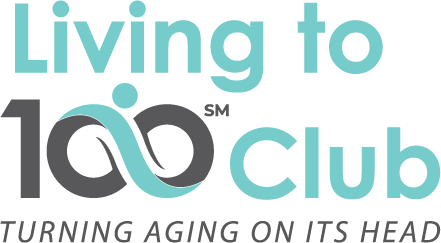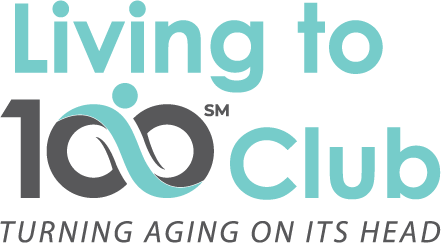by Joe Casciani
OPENING
This is the third in a series of articles on the principles of positive psychology. The first two looked at “explanatory styles” or how we explain and interpret different events in our lives and the concept of “re-framing” or seeing the glass as half-full instead of half-empty. In this article, we explore affirmations, the process of shifting our self-talk from negative to positive. This series was originally written for those caring for older adults in long term care settings: nursing and activities staff, rehabilitation professionals, administrative staff, and the many other positions that can be very demanding, stressful, and often falling short of the job satisfaction and reward that other industries afford its employees. This current version of an inside look at positive psychology has been adapted to the Living to 100 Club readers and enthusiasts, with all of the principles still relevant and applicable to our daily lives.
Before delving into the notion of affirmations, I want to review some of the basic principles of positive psychology, previously discussed:
- First, it is not possible to always control the events in our lives, but it is possible to control our reactions. We can choose how we want to respond to these events, and we know responding in a positive, constructive manner is more valuable than a negative reaction. A simple example is our response to the way someone cuts us off in traffic – this is a good indicator of how we choose to react.
- Second, we can control, change, and redirect our thoughts away from negative, self-limiting self-talk and toward more positive, self-enhancing thoughts that enhance our self-confidence, personal well-being and happiness.
- Third, positive psychology also means looking for and complimenting the positive qualities – appearance, actions, cooperative attitudes – that we observe in others. In this way, we enhance the lives of others and create positive feelings for ourselves in return.
- And finally, reflecting on the positive experiences of the day is a calming activity, especially as we retire for the evening. If we take the time to recall a few positive events in our day that we experienced or caused, we will experience peace, calmness, and confidence as we go off to sleep.
WHAT ARE AFFIRMATIONS?
Positive affirmations are a useful tool to reprogram our unconscious mind from negative to positive thinking. This approach has us take positive statements that we would like to see manifested and repeat them enough so that they’re part of the way we think and see the world. This operates in the same way that negative self-talk does, but in a constructive, beneficial way. Positive affirmations can also help you re-program yourself and your way of thinking so that positive thinking becomes more automatic and less something to think about deliberately. To create your own positive affirmations, use the following guidelines:
Observe Your Intentions:
- Think about what you are trying to create in your life. This means, look at the end goal, and the behaviors, attitudes and traits that you need to develop in order to get there. Would you like to feel more peace? Would you like to practice healthier lifestyle habits? Would you like to be a more supportive friend?
- You might want to write in a journal and brainstorm to figure out what’s important to you and get to the heart of what you want to create in your life.
- A good starting point is to imagine your ideal life: pretend a magic fairy has given you three wishes or visualize what you were put on Earth to be.
Think of New Statements:
- Once you get an idea of what you’re aiming for, try to put that idea into a few simple statements that reflect the reality of what you want to create. Phrase the statements as if they are already true, not that you would like them to be true. For example, the affirmation, “I am feeling more peaceful each day,” would be better than, “I want to feel more peaceful.”
- You are programming your subconscious mind thru repetition to believe the statements, and that helps manifest them into reality. It is not a matter of trying to want something, rather you are trying to make it so.
Be Sure They’re Positive:
- When making positive affirmations, make sure they are positive statements. This means saying what you want to see and experience, not what you don’t want to see and experience. For example, instead of saying, “I don’t want to feel stress,” or “I’ve stopped feeling stress,” make an affirmative statement like, “I’m feeling peace.”
Affirmations Need to be Realistic:
- Your subconscious mind can benefit from positive affirmations that stretch and expand your perspective, but if you push things too far, your critical thinking steps in and negates the affirmations. Be sure that you’re making your affirmations realistic, but hopeful as well, and positive affirmations will work for you.
- For example, the popular affirmation, “Every day, in every way, I’m getting better and stronger” might feel like too much of a stretch, and your subconscious mind might disagree and fight this positive thinking. However, “I am learning from my mistakes,” or “I am grateful for all that I have in my life,” might feel more real to your subconscious mind. Experiment, and see what feels right to you.
EXAMPLES OF POSITIVE AFFIRMATIONS
Positive affirmations can be a powerful tool in transforming negative self-talk into motivational and affirming self-talk. Here are some affirmations you can use that are designed to reduce stress, increase feelings of personal power, and awaken your mind to possibilities for change:
- CHALLENGES HELP ME GROW
- I CAN CHOOSE A POSITIVE FRAME OF MIND
- I CAN HANDLE WHATEVER COMES
- I CAN ACCOMPLISH ANYTHING
- I CAN HANDLE WHATEVER COMES
- I CAN CREATE INNER PEACE
- I AM STRONG
- STRESS IS LEAVING MY BODY
- TODAY I CHOOSE JOY
- I CAN MAKE HEALTHY CHOICES
- I BREATHE IN PEACE
- I AM IN CHARGE OF MY LIFE
- I HAVE MANY OPTIONS
- I CAN CREATE POSITIVE CHANGE
- I CAN START HEALTHY HABITS
- EACH MOMENT BRINGS CHOICE
- I CAN STAY CALM UNDER PRESSURE
| Exercise: Create positive affirmations that say something about what you want to see for yourself, what you are trying to create, what you would like to see for your family, network or community, what communication style you would like to create for them. Imagine your ideal work or home life and awaken yourself to the possibility of change: what intentions, what behaviors, attitudes, or traits do you need to develop to get there. Then, create positive statements as if you are already there, new self-statements that you are preparing to believe and adopt. Must be realistic (can’t be winning the lottery). Write down your new positive affirmation. |
Once you’ve found your affirmations, here are some ways to introduce these affirmations into your life:
- Repeating Them Often: Probably the most popular way to harness the power of affirmations is to simply repeat them to yourself on a regular basis. Repeating them mentally several times in the morning or evening can be effective; repeating them aloud is even more effective because you hear them more clearly that way.
- Make a Recording: You can make a recording of yourself repeating positive affirmations and play it as you drive, get ready in the morning, or do other activities. Talk in a calm voice, maybe play your favorite soothing music in the background, and you have a recording tailor-made especially for your needs.
- Use Post-Its: A fun way to use affirmations is to put them on post-its that you place around your house (on the fridge, on the bathroom mirror, and other places you’ll likely see them) to give yourself positive messages throughout the day.
CLOSING
It is possible, realistic, and probable to adopt these principles as we face new challenges, as we get rid of the mental clutter that gets in the way of seeing the good in ourselves and all around us, and as we look ahead at what the future holds for us. As I’ve said, Living to 100 is more a metaphor than
Look for another positive psychology article in the weeks ahead exploring the notion of resilience, the ability to adapt to or cope with stressful situations or crises. It’s in all of us, though sometimes blocked or locked away and often hard to tap, but always available and retrievable when needed. Stay tuned.

